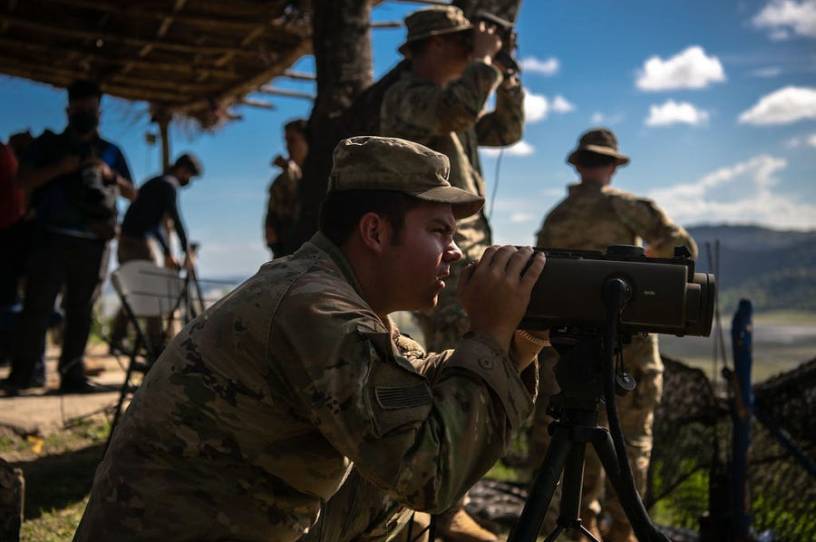To Bolster Deterrence, the U.S. Must Work With the Philippines

President Joe Biden is right to be clear that the U.S. will defend Taiwan if the People’s Republic of China attacks it, notwithstanding his aides’ attempts to “walk back” his pledge. Presidential statements about U.S. intent to oppose China’s use of force provide the basis for a coalition to deter Beijing’s use of force. But statements are not enough.
A deterrent coalition needs to demonstrate that it can effectively defeat the Chinese military. This requires a build-up of U.S. military force in the region together with Japan and Australia as well moves to secure the use of allied bases. No country is geographically more important to such a coalition than the Philippines. But the alliance has been rocky since the U.S. military was forced to withdraw from the country in the early 1990s. The Biden administration needs to prioritize stabilizing ties with Manila, not an easy task with the new Marcos government.
The U.S. was instrumental in ousting Ferdinand Marcos, a very popular policy in the Philippines at the time. But after the recent presidential victory of Ferdinand Sr.’s son, Ferdinand “BongBong” Marcos Jr., the family is back in power. The Marcoses are clearly not fond of the U.S., where they still face legal trouble. Meanwhile, Beijing cultivated the new Philippine government before it ascended to power. The Chinese invested in Davao City in Mindanao when Vice President Sara Duterte, daughter of outgoing President Rodrigo Duterte, was mayor.
Despite these obstacles, the U.S. has an opportunity to improve the Philippine alliance. It should develop a comprehensive “Plan Philippines” that leads with diplomacy and economic inducements. One of the plan’s main goals should be to re-establish U.S. bases. This would be a major victory for deterrence in Asia, as Washington’s chief geostrategic problem is the absence of permanent military access south of Okinawa. The Philippines, situated at the eastern edge of the South China Sea, is less than 800 miles away from Taiwan and 900 miles from China’s Hainan province, which is home to a Chinese naval base. It is no surprise, then, that most of the more innovative warfighting concepts offered by the Defense Department assume the use of the Philippines. Unless alliance relations are improved, this is a faulty assumption.
The good news is that a “Plan Philippines” would not be starting from square one. In 2014 the U.S. signed the Enhanced Defense Cooperation Agreement, which allowed U.S. forces to deploy to the Philippines on a rotational basis and for the storage of U.S. military equipment. It also provides the ballast for more joint training opportunities, and the two countries have enjoyed a steady pace of counter-terror exercises. Despite this, only one storage facility has been built at Basa Air Base. The two countries have yet to build four more such sites.
Notwithstanding the glacial pace of relations with the Philippines, even under the populist, anti-American President Duterte, Manila did not fully jettison the pact. Filipinos do not want to lose more maritime territory to China or the ability to lawfully use the South China Sea for economic purposes. Since 2012,China has blocked access to the Scarborough Shoal and interfered with Filipino oil and gas exploration at Reed Bank.
A 2016 U.N. Hague tribunal found those actions to violate international law and concluded that China’s expansive claims to areas inside the Philippine’s Exclusive Economic Zone have no legal basis. But absent enforcement by the U.S. and its allies, the tribunal’s decision has meant nothing. China has steadily built military outposts around the Spratly archipelago, strengthening its expansive claims around the Philippines.
U.S. diplomacy in Southeast Asia is tricky. Even, with a clear security interest in a more fulsome American presence, Manila has not pushed for a permanent presence of U.S. forces. It is not convinced that the U.S. presence will endure, whereas China is a big menacing neighbor.
Given this mixed history with Manila, a new Philippine strategy will have to include real economic inducements, notably absent from Washington current economic approach to Asia. The Philippines is a developing economy, unable to contribute extensively to its own security. The Development Finance Corporation, formed to counter China’s Belts and Road Initiative (its program to expand its economic influence), should take over infrastructure investments where China has promised money that Manila will never see. While China can out-promise the U.S., its record of delivery is mixed. The U.S. can draw a contrast between glitzy Chinese announcements and actual work completed, starting with funding projects for their viability and commercial value.
In addition, the U.S. has to get back into the trade game in a more serious way. Negotiating a free trade agreement with an ally vital to national security should be possible if the Biden administration is genuinely committed. The keys to success are concrete benefits to the Philippines and an endorsement of the bilateral relationship. In addition to encouraging Manila to cooperate on security issues, this will encourage multinationals to shift activity to the Philippines, including activity from China and possibly extending to semiconductors. While conventional macroeconomic gains for the U.S. would be very small, the past several years have underscored the need for supply chain resilience and movement from China to the Philippines would help. Indeed, absent such free trade agreements the U.S. will likely fail to reshape supply chains.
A new “Plan Philippines” would provide Manila with both more security and access to the massive U.S. market. The U.S. would get permanent bases, and the region would take a strong step toward deterring a potential conflict. This strategy may involve some unwholesome decisions by U.S. policymakers. They may have to tacitly accept continued corruption. But the alternative is worse: a democratic Taiwan becoming indefensible, and the U.S. position in Asia becoming untenable.